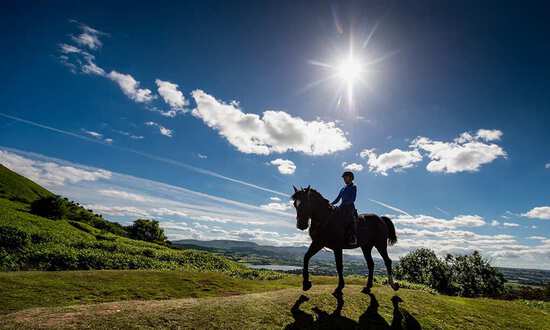


Spurs from Horze are available in simple classic flat, round, or Prince of Wales styles, or more serious types such as round end or rowelled styles. Some Horze spurs offer added crystal accents for a bit of sparkle. Choose the style of spur that’s right for your horse’s needs and always use care when riding with spurs. Gentle encouragement and an added reinforcement of the leg aids are the intention of proper spur use. Never use spurs to injure a horse. Be sure to check the limits and requirements of your show or event circuit to purchase the spurs that are right for your needs. Horze spurs are designed in high quality stainless steel for durability and shine with a no-rust finish.
Replace your spur straps often for safety reasons and to maintain a polished look. Add a touch of sparkle with crystal accents or a trendy logo. For a more traditional look in a classic, formal setting, choose spur straps in traditional black leather. Nylon webbing spur straps are perfect for daily use as the strap can be quickly adjusted for comfort and positioning. Horze spur straps are affordable and come in a variety of styles to match the rest of your look.
Spurs are used to give the horse specific aids. They have a more selective effect than thigh aids. However, the use of spurs has to be practiced, otherwise the horse might be injured. The prerequisite for their use should be confidence and stability in the saddle. This does not tend to be the case with beginners, and so beginners should ride without spurs if possible. An exception is when the rider is very tall compared to the horse. Then they may be needed to prevent the rider's leg from constantly being pulled up. In this case, swan-neck spurs should be chosen. They get their name from the swan-neck-like upward bend of their spines. This makes it possible to give aids to a relatively small horse without pulling up the heel.
Spurs are attached to the back of the boots. In principle, there are three ways to do this. Spurs can be strapped to the boot as needed with the help of a strap that runs in front of the heel and around the instep. This is the most common type used today. For clip-on spurs, you need appropriately prepared boots. The heel of the boot must have a hole and a guide for this. The spur is inserted into the hole with a pin. The third variant are the buckle spurs, which are firmly attached to the boot. Strapped spurs have the great advantage that they can be used quickly and easily with almost any boot or riding shoe. They are only put on before riding and taken off again directly after riding. This also reduces the risk of injury for horse and rider.
The answer to this question depends on whether you are a dressage, show jumping, western, or leisure rider. Western riders generally use wheel spurs. They are long and have a rotating wheel at the end. You will also find rowel spurs among dressage riders. Dressage riders often use styles with straight spurs that are bevelled or rounded at the end. If the end of the spike is a ball, they are round end spurs. If the end of the spike has a hammer shape, they are called hammerhead spurs.
Show jumpers can also use these styles, but they use them less often. For leisure riders, all types of spurs are actually unnecessary. When you start riding with spurs, you should first choose the mildest possible versions. These are all models whose spikes have a rounded end.
Many people believe that you can make a horse go faster by using spurs, but this is not true. Spurs are used for targeted, impulse-like aids. This is mainly needed in dressage and western riding. Even though this is not the original purpose of these aids, the different types of spurs are often used to urge horses that are not very willing to move. However, you must be careful to give only a short impulse just behind the girth.
Under no circumstances should spur riding degenerate into constant tapping against the horse's belly. This would not only deaden the animal, but also cause injuries to the sensitive skin of the belly. Well trained dressage horses can be brought to a greater collection with the correct use of spurs. The rotation of the foot is usually sufficient for this. For small horses, it is advisable to use swan-neck spurs.